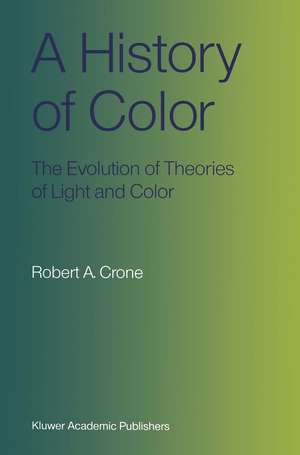A History of Color: The Evolution of Theories of Light and Color
Autor Robert A. Croneen Limba Engleză Paperback – 8 iul 2012
A History of Color has been written for ophthalmologists, optometrists and others who are interested in visual science and its history. The book requires no specialized knowledge.
Preț: 746.10 lei
Preț vechi: 785.37 lei
-5% Nou
Puncte Express: 1119
Preț estimativ în valută:
142.79€ • 148.52$ • 117.88£
142.79€ • 148.52$ • 117.88£
Carte disponibilă
Livrare economică 24 martie-07 aprilie
Livrare express 08-14 martie pentru 32.40 lei
Preluare comenzi: 021 569.72.76
Specificații
ISBN-13: 9789401539418
ISBN-10: 9401539413
Pagini: 296
Ilustrații: 292 p. 36 illus., 7 illus. in color.
Dimensiuni: 155 x 235 x 16 mm
Greutate: 0.42 kg
Ediția:Softcover reprint of the original 1st ed. 1999
Editura: SPRINGER NETHERLANDS
Colecția Springer
Locul publicării:Dordrecht, Netherlands
ISBN-10: 9401539413
Pagini: 296
Ilustrații: 292 p. 36 illus., 7 illus. in color.
Dimensiuni: 155 x 235 x 16 mm
Greutate: 0.42 kg
Ediția:Softcover reprint of the original 1st ed. 1999
Editura: SPRINGER NETHERLANDS
Colecția Springer
Locul publicării:Dordrecht, Netherlands
Public țintă
ResearchCuprins
I Color theory in the ancient world.- Empedocles’ four elements and four colors.- The four-color doctrine.- Atomism and idealism: Democritus and Plato.- The empiricism of Aristotle.- The influence of Plato and Aristotle on science.- The Hellenistic and Roman era.- Neoplatonism.- The end of ancient scholarship.- II The Middle Ages.- The early Middle Ages.- The visual science of the Islamic world.- The controversy about visual rays.- Ibn Al-Haytham (Alhazen).- Alhazen’s theory of vision.- Colors.- The refraction of light.- The science of vision and colors in the prime of the Middle Ages.- The perspectivists.- III The Renaissance.- Color in the Renaissance.- Optics in the Renaissance.- Johannes Kepler.- IV Light, color and vision during the scientific revolution.- The scientific revolution.- Kepler and Galileo.- Bacon, Gassend and Descartes.- Descartes and vision.- New theories of light and color.- The speed of light.- The refraction of light.- The rainbow.- The chemical colors.- The color theories of opponents of the corpuscular hypothesis.- V Newton.- A new theory of light and color.- Newton’s color system.- The barycentric system.- The physiology of color vision.- VI From Newton to Young.- The reception of Newton’s color theory.- Supporters of the medium hypothesis.- Intermezzo: achromatic lenses.- Supporters of the corpuscular hypothesis.- Conservative Aristotelians.- Practitioners on the classification of colors.- Three-color printing.- The first color triangles.- Butterflies and color-tops.- The start of color physiology.- The retina sensitive to three sorts of light?.- Thomas Young.- Theory of light.- Fresnel.- Invisible light.- Theory of color vision.- VII Classical-romantic color theory in Germany.- Runge.- Goethe.- Intermezzo: subjective colors beforeGoethe.- Back to Goethe.- Schopenhauer.- VIII Disorders of color vision.- Dalton.- Goethe.- Schopenhauer.- Seebeck.- IX The mixing of colors.- Primary colors and the mixing of pigments.- Optic color mixing.- Wünsch.- Chevreul.- Voigt, Young and Forbes.- Helmholtz.- Mixing spectral colors.- X The trichromatic theory.- Helmholtz.- Grassmann.- Limitations of Grassmann’s system.- Maxwell.- Colorimetry.- The fundamental sensation curves.- Trichromatism and dichromatism.- Arthur König.- Anomalous trichromatism.- Psychophysics.- Aubert and Mach: color as subjective quality.- XI Hering’s four-color theory Zone theories.- Theory of the four opponent colors.- Fick’s hypothesis.- Zone theories.- XII Anatomy and physiology of the visual system between 1600 and 1900.- Anatomy of the retina.- The neural structure of the retina.- Anatomy of the visual pathways.- The duplicity theory.- Day-blindness and night-blindness.- Visual pigment.- The Purkinje shift.- The photopic luminous efficiency function (V lambda function).- Dark adaptation.- XIII The twentieth century.- The quantum theory.- The impact of the quantum theory on the science of vision and color.- The physics of color.- Photochemical processes.- The quantum theory and the limits of vision.- The absolute threshold of vision.- The relative threshold of vision.- The relative thresholds of color vision.- Our spectral window and the quantum theory.- Other important aspects of the twentieth century color theory.- The further development of color theories.- The trichromatic theory.- Luminance and color.- Zone theories.- Electronmicroscopy of the retina.- New facts about color vision defects.- Heredity.- Tritanopia.- Monochromatism.- The visual pigments.- The rod-pigment.- The cone-pigments.- Retinal densitometry.- Conehistochemistry.- Microspectrophotometry.- The structure of the cone pigments.- The evolution of color vision.- The neurophysiology of the retina.- Action potentials.- The horseshoe crab.- The visual nerve of the frog.- The receptive field.- Stimulation of the retinal ganglion cells with colored lights.- Electrophysiology of the cones.- Opponent processes.- The advantages of an opponent organization.- Color and luminance channels from retina to visual cortex.- Color psychology in the twentieth century.- The classification of colors.- The names of colors.- Contrast.- The influence of boundaries.- Color adaptation and color constancy.- The cortical color mechanism.- Functional specialization in the areas of the visual cortex.- Appendix and synopsis; what is color?.- Color and presciantific man.- The history of color theory.- Aristotle.- Alhazen, Bacon, Kepler.- Mechanicism and the subjectivity of the concept of color.- From Newton to the trichromatic theory.- Hering.- Modern color physiology.- The future of color science.- Notes.- Acknowledgments.- References.









